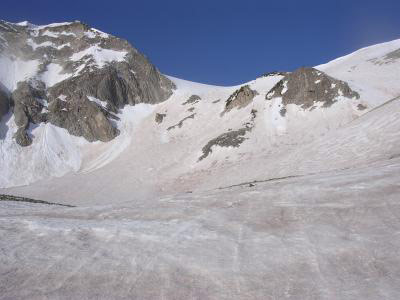Arizona Dust Causes Colorado Meltdown

Wind-blown dust from the drought-stricken Southwest can speed the melt of snow in Colorado’s mountains, yet another unpredictable effect of climate change, a new study shows.
In 2006, snows in areas of Colorado's San Juan Mountains above and below the tree line (above which trees can no longer grow), unexpectedly melted a month earlier than usual.
The cause for the premature melt was dust, most likely originally from parched deserts in Arizona and New Mexico, hundreds of miles away.
The dust is less reflective than snow and so reduces the overall reflectivity of the area, allowing for more of the sun’s energy to warm, and subsequently melt, the snow pack. A similar effect of dark soot falling on Arctic snow is thought to speed melting there.
“The connection between dust and lower snow reflectance is already established, but the amount of impact measured and modeled in this system stunned us,” said study team leader Tom Painter of the University of Colorado at Boulder’s National Snow and Ice Data Center. “The fact that dust can reduce the snow cover duration so much—a month earlier—transforms our understanding of mountain sensitivity to external forcings.”
There were eight dust deposition events in 2006, up from only three or four between 2003 and 2005, according to the authors of the study, detailed in the June 23 issue of the journal Geophysical Research Letters.
Snowmelt provides one-sixth of the world’s population with drinking water, and is important to sustain agriculture in the western United States.
Sign up for the Live Science daily newsletter now
Get the world’s most fascinating discoveries delivered straight to your inbox.
The expected exacerbation of western droughts brought about by global warming will likely make the situation snowball.
“Recent studies agree that with global warming, the Southwest will be warmer and drier,” Painter said. “Enhanced dust deposition is likely, further shortening snow cover duration.”
“Ultimately, a warming climate and the dust it generates will affect river run-off and soil moisture in the mountains,” he added. “Not only in the Western United States, but across many of the world’s mountains.”

Andrea Thompson is an associate editor at Scientific American, where she covers sustainability, energy and the environment. Prior to that, she was a senior writer covering climate science at Climate Central and a reporter and editor at Live Science, where she primarily covered Earth science and the environment. She holds a graduate degree in science health and environmental reporting from New York University, as well as a bachelor of science and and masters of science in atmospheric chemistry from the Georgia Institute of Technology.










